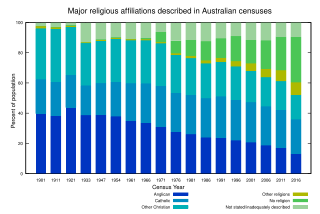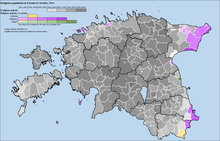Irreligion is the absence or rejection of religious beliefs or practices. It encompasses a wide range of viewpoints drawn from various philosophical and intellectual perspectives, including atheism, agnosticism, skepticism, rationalism, and secularism. These perspectives can vary, with individuals who identify as irreligious holding a diverse array of specific beliefs about religion or its role in their lives.

In sociology, secularization is a multilayered concept that generally denotes "a transition from a religious to a more worldly level." There are many types of secularization and most do not lead to atheism, irreligion, nor are they automatically anti-thetical to religion. Secularization has different connotations such as implying differentiation of secular from religious domains, the marginalization of religion in those domains, or it may also entail the transformation of religion as a result of its recharacterization.

State atheism or atheist state is the incorporation of hard atheism or non-theism into political regimes. It is considered the opposite of theocracy and may also refer to large-scale secularization attempts by governments. To some extent, it is a religion-state relationship that is usually ideologically linked to irreligion and the promotion of irreligion or atheism. State atheism may refer to a government's promotion of anti-clericalism, which opposes religious institutional power and influence in all aspects of public and political life, including the involvement of religion in the everyday life of the citizen. In some instances, religious symbols and public practices that were once held by religions were replaced with secularized versions of them. State atheism in these cases is considered as not being politically neutral toward religion, and therefore it is often considered non-secular.

Atheism, agnosticism, scepticism, freethought, secular humanism or general irreligion are increasing in Australia. Post-war Australia has become a highly secularised country. Religion does not play a major role in the lives of much of the population.

Estonia, historically a Lutheran Christian nation, is today one of the least religious countries in the world in terms of declared attitudes, with only 14 percent of the population declaring religion to be an important part of their daily life. This is thought to largely be a result of the Soviet occupation of Estonia in 1940, prior to which Estonia had a large Christian majority.
Irreligion in Belgium pertains to citizens of Belgium that are atheist, agnostic, or otherwise unaffiliated with any religion. Irreligion is the second most common religious stance in Belgium, following Catholicism.
Irreligion in the Czech Republic pertains to atheism, agnosticism, and lack of religious affiliation in the Czech Republic. The history of irreligion in the Czech Republic dates back to 19th century freethought and saw additional developments during Communist rule. A majority of people in the Czech Republic are irreligious or otherwise unaffiliated, and the country is considered to be one of the most irreligious in the world.

Irreligion is prevalent in Germany. In a time of near-universal adoption of Christianity, Germany was an intellectual centre for European freethought and humanist thinking, whose ideas spread across Europe and the world in the Age of Enlightenment. Later, religious traditions in Germany were weakened by the twin onslaughts of Nazi rule during World War II and that of the Socialist Unity Party in East Germany during the Cold War. In common with most other European societies, a period of secularisation also continued in the decades that followed. While today Christianity remains prevalent in the north, south, and west of Germany, in the east relatively few Germans identify with any religion whatsoever.

Irreligion in Ireland pertains to the population of Ireland that are atheist, agnostic, or otherwise unaffiliated with any religion. The 2022 census recorded that 14% of the population was irreligious; the second largest category after Roman Catholicism. The population was traditionally devoutly Catholic throughout much of Ireland's modern history, with a peak of 94.9% identifying as Catholic in the 1961 census. This percentage has declined to 69% in the 2022 census, the lowest recorded. Conversely, those with no religion made up less than 0.1% of the population in 1961; the proportion grew slowly until the 1991 census where it began to rapidly increase to its current share of 14% of the population in 2022.
China has the world's largest irreligious population, and the Chinese government and the ruling Chinese Communist Party (CCP) are officially atheist and have conducted antireligious campaigns throughout their rule. Religious freedom is nominally protected under the Chinese constitution. Among the general Chinese population, there are a wide variety of religious practices. The Chinese government's attitude to religion is one of skepticism and non-promotion.

Irreligion in Bulgaria pertains to atheism, agnosticism, and secularism among the citizens of Bulgaria. Irreligion is a minority religious position in Bulgaria. Making up approximately 5-10% of Bulgarians, irreligion is the second most common religious stance after Eastern Orthodoxy. Irreligion in Bulgaria is closely tied to the history of Marxism–Leninism and Soviet rule in the country during the 20th century.
Irreligion in Latin America refers to various types of irreligion, including atheism, agnosticism, deism, secular humanism, secularism and non-religious. According to a Pew Research Center survey from 2014, 8% of the population is not affiliated with a religion. According to Latinobarómetro, the share of irreligious people in Latin America quadrupled between 1996 and 2020, from 4% to 16%.
Irreligion in Romania is rare. Romania is one of the most religious countries in Europe, with 92% of people saying that they believe in God. Levels of Irreligion are much lower than in most other European countries and are among the lowest in the world. At the 2011 census, only 0.11% of the population declared itself atheist, up from the 2002 census, while 0.10% do not belong to any religion. While still one of the most religious countries in Europe, practicing, church and mass attendance is quite low, even compared to some less religious countries than Romania. It is mainly practiced by elderly people, mainly in rural areas, while in urban areas church attendance and practice is much lower. As of 2021, almost 85% are declared religious, of which about 73% are declared orthodox, 12% other religions, about 1% atheists or irreligious and about 14% declared nothing about religion.

Irreligion in Croatia pertains to atheism, agnosticism, and lack of religious affiliation in Croatia. Even though the 2011 census showed that only 4.57% of Croats considered themselves irreligious, Gallup polls conducted in 2007 and 2008 found that 30.5% of respondents did not consider religion important in their lives. The Japanese research center, Dentsu, conducted a survey in 2006 concluding that 13.2% of Croats declare themselves irreligious, compared to the 7% found by a 2010 Eurobarometer survey across Europe.
Irreligion in Italy includes all citizens of Italy that are atheist, agnostic, or otherwise irreligious. Approximately 12% of Italians are irreligious, and no affiliation is the second most common religious demographic in Italy after Christianity. Freedom of religion in Italy was guaranteed by the Constitution of Italy following its enactment in 1948. Until then, the Catholic Church was the official state church of Italy.
Irreligion in Montenegro refers in its narrowest sense to agnosticism, atheism, secular humanism, and general secularism. Increase of the number of irreligious people is usually interpreted by the modernization marked with tendency of secularization and the progress of science and technology that directly affect human society.

Irreligion in Hungary pertains to atheism, agnosticism, and secularism in Hungary. The tradition of irreligion in Hungary originates from the time of Austria-Hungary and it was a significant part of Communist rule in the second half of the 20th century. As of 2011, irreligion is the country's second largest religious stance after Catholicism.
Irreligion in Latvia pertains to atheism, agnosticism, and lack of religious affiliation in Latvia. Irreligious thought in Latvian history is associated with national identity and a period of Communist rule. The irreligious make up a significant minority group in Latvia today, with 29% of Latvians identifying as irreligious.
Irreligion in Lithuania pertains to atheism, agnosticism, and lack of religious affiliation in Lithuania. Irreligious Lithuanians make up a small minority of the population, encompassing only 6.11% of the population in the Lithuanian census of 2021. Irreligion in Lithuania is associated with the period of Soviet rule in the late 20th century.









